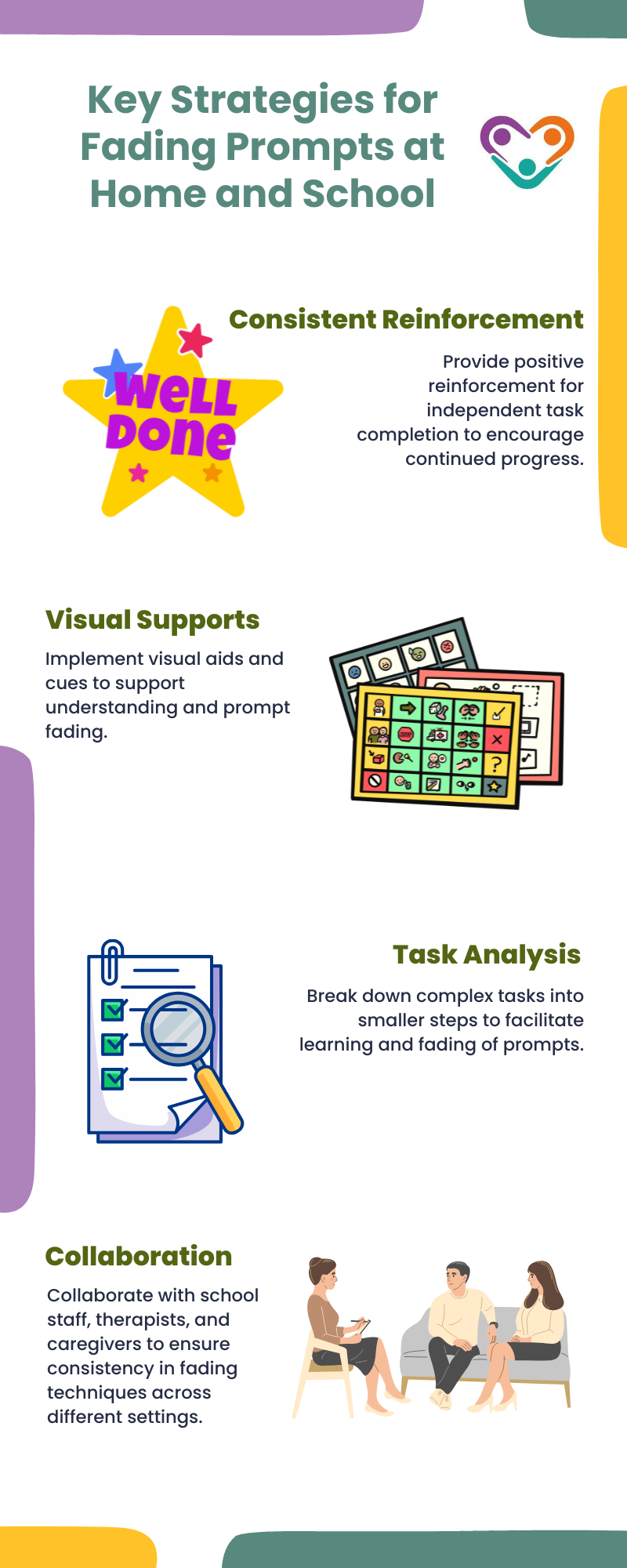Fading is a key technique used in Applied Behavior Analysis therapy to help individuals learn new skills and become more independent. By gradually reducing the level of support provided, fading aims to make the transition from assistance to complete independence as smooth as possible.
This method allows individuals to build confidence and skills at their own pace, while still receiving the guidance they need.
Understanding how fading works and its effectiveness can provide valuable insights into its role in helping individuals achieve their goals in ABA therapy.
Importance of Fading in Skill Acquisition
Fading plays a key role in skill acquisition, particularly for individuals with autism. A fading strategy can aid in transferring prompts to the natural stimulus, fostering a sense of independence and self-reliance in learning new skills. By systematically reducing prompts over time, individuals are encouraged to generalize learned behaviors across various contexts and settings.
To ensure the effectiveness of fading in ABA therapy, a systematic approach to fading prompts is essential. This process involves gradually developing a structured plan to decrease the level of assistance provided to the individual.
This systematic fading of prompts is critical in preventing individuals from becoming overly dependent on specific cues or prompts when acquiring new behaviors.
Implementing a systematic fading process helps therapists and caregivers tailor the level of support to the individual’s needs, gradually transitioning from constant prompting to more independent skill execution.
This methodical approach helps build confidence and autonomy in autistic individuals, paving the way for sustainable skill development and long-term behavioral progress.
Fading prompts systematically is integral to the success of ABA therapy interventions, as it enables individuals with autism to internalize learned behaviors and apply them autonomously in various real-life situations.

Implementing Fading Techniques
To implement fading techniques in ABA therapy, it is crucial to have a systematic approach to gradually reduce prompts and assistance to enhance skill acquisition. Fading prompts in a structured manner aims to prevent individuals, especially those with autism, from relying too heavily on prompts for performing tasks.
Let’s explore the sequences involved in fading prompts and the strategies applicable in both home and school settings.
Sequences in Fading Prompts
Fading prompts in ABA therapy involve a step-by-step process to diminish the level of support provided to individuals as they learn new skills. By systematically reducing prompts, individuals are encouraged to develop independence in performing tasks.
Sequences in fading prompts often include the following:
- Supporting Wrists: Guiding the individual’s wrists
- Lightly Touching Hands: Providing a gentle touch on the hands
- Touching Forearm or Elbow: Transitioning to physical support on the forearm or elbow
- Withdrawing Physical Contact: Gradually removing physical contact while the individual completes the task independently
This progressive sequence ensures that the individual does not become overly reliant on prompts, facilitating skill acquisition and promoting independence.
Fading Strategies at Home and School
Fading strategies can be effectively implemented in both home and school environments to facilitate skill development in individuals with autism. The goal is to gradually reduce prompts to enable individuals to perform tasks autonomously.
Establishing a fading plan is essential to ensure a systematic and gradual reduction of prompts. Some key strategies for fading prompts include:

Incorporating fading strategies into daily routines both at home and in educational settings allows autistic individuals to effectively acquire new skills while gradually reducing dependency on prompts.
This approach promotes independence and fosters skill development in a supportive and structured environment.
Effectiveness of Fading in ABA
Fading techniques play a crucial role in promoting skill acquisition and reducing maladaptive behaviors in individuals with autism. Certain studies have delved into the efficacy of fading within the realm of ABA, particularly in addressing challenging behaviors and enhancing learning outcomes.
Studies have consistently highlighted the effectiveness of fading as a vital component of ABA interventions for autistic individuals. These studies have explored the impact of fading in conjunction with other behavioral techniques, such as reinforcement and demand fading.
The results have shown that fading procedures can lead to significant improvements in skill development and behavior reduction, providing a structured approach to shaping desired behaviors.
One area where fading has shown notable success is in the reduction of maladaptive behaviors commonly observed in autistic individuals. By systematically fading out prompts and supports while reinforcing positive behaviors, ABA therapists can effectively target and diminish unwanted behaviors.
Fading techniques help individuals transition from prompted or prompted behaviors to more independent and adaptive responses, ultimately leading to long-term behavior change.
In specific instances, such as addressing feeding challenges in children with autism, stimulus fading combined with reinforcement strategies has proven highly effective. By gradually exposing individuals to nonpreferred foods in small, manageable increments and reinforcing acceptance, therapists can increase food consumption and expand dietary variety.
This combined approach exemplifies the power of fading techniques in enhancing outcomes for individuals with complex behavioral needs.
Combining Fading Techniques
Combining fading techniques can be a powerful strategy for promoting skill acquisition and behavior change. Two key fading techniques commonly employed in ABA therapy are prompt fading and stimulus fading.
Let’s look at the integration of these techniques and their application in rehabilitation settings.
Prompt Fading and Stimulus Fading
Prompt fading and stimulus fading are both pivotal components of ABA interventions aimed at promoting adaptive behaviors and reducing maladaptive ones.
Prompt fading involves gradually reducing or eliminating prompts that assist an individual in performing a specific behavior. On the other hand, stimulus fading entails the gradual removal of prompts or cues from the individual’s environment to promote independent responses.
In practice, prompt fading may involve initially physically guiding an individual to engage in a behavior and then systematically reducing the physical guidance until the behavior can be performed independently.
Stimulus fading, on the other hand, may entail gradually reducing the salience of a cue or prompt until the behavior can be elicited in the absence of the original stimulus.
An illustrative example of combining prompt fading and stimulus fading could be seen in a rehabilitation setting. For instance, in physical therapy, prompt fading may involve reducing physical assistance provided to a patient during gait training.
Over time, the therapist gradually withdraws the level of physical support until the patient can walk independently without prompts.
Simultaneously, stimulus fading may involve decreasing the visual cues present in the environment, such as handrails or markers, to encourage the patient to rely on internal cues for gait control.
Fading in Rehabilitation Settings
In rehabilitation settings, the integration of fading techniques plays a critical role in promoting independence and functional skill mastery among individuals undergoing therapy.
The gradual reduction of prompts and cues not only fosters independent performance of targeted behaviors but also enhances generalization across different settings and situations.
Harnessing the synergistic effects of prompt fading and stimulus fading helps practitioners create individualized treatment plans that optimize learning outcomes and promote lasting behavior change in individuals undergoing ABA therapy. These strategies are implemented across various locations, including our ABA center in New Jersey, New York, Georgia, and Indiana.
To learn more about how these approaches can benefit your loved one, contact us at Golden Care Therapy today for personalized support and guidance.
Sources:



